In Search of Driver/Mechanician Charles Burman Updated: 10/30/2019
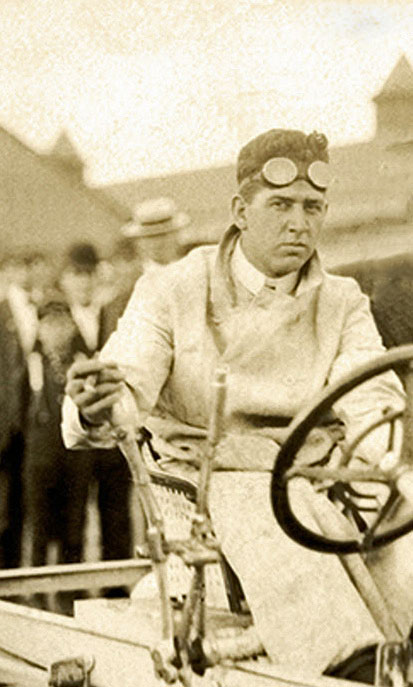
Charles M. Illgen is looking for assistance in assembling information on his relative Charles Burman, who worked with Vanderbilt Cup Racer Joe Tracy and set speed records and perfect Glidden scores in Peerless automobiles from 1905 to 1908.
Below is information and photos from Charles Illgen and the research that I was able to uncover in my collections. If you have any additional documentation, please forward to [email protected] .
Enjoy,
Howard Kroplick
Charles Burman by Charles M. Illgen
Howard, I appreciate all of your enthusiasm and good work keeping our "collective" automotive history alive. I am assembling Charles Burman's archives from the very early days of racing, and hope that there might be more information available. He was a pioneer, yet his story has never been told. His image is three times in William F. Nolan's biography of Barney Oldfield, without a mention.
"Charlie" was my Mother's uncle and, like Tom Cooper and Barney Oldfield, was first a bicycle racer, then worked for Winton in 1900, and then transferred to Peerless from 1901 untill 1912. Burman was fortunate to work with the brilliant Louis P. Mooers, and by his own hand wrote "I personally and under the instruction and guidance, built the first three speed transmission used in American automobiles, R.P.Mooers designer and engineer."
Burman shows up in pictures- I've included a couple- at the 1904 Ormond Sands as a mechanic for the Gordon Bennett car with Joe Tracy at the wheel. I believe that the five-mile trial is the only event that car entered and possibly Bill Staring was the riding mechanic? Do you have any information or photos of that race that would help identify the entry?
It seems that Tracy kept that car and used it for practice for the Vanderbilt Cup later in 1904 and then the auto disappears, I have seen pictures over at the "The Old Motor" site, of the car and I know there is much discussion about how many and what cars are called the "Dragons," and I hope to eventually add some clarification to the discussion.
Burman took the wheel of the Peerless 24 h.p. "stripped touring car," later in 1904, and by the end of the year- barnstorming with Barney Oldfield- is credited with the "world's records" in that class for one mile, and from 6 to 25 miles.
In 1905 Charlie competed in the AAA's first National Championship in an "overslung" car, winning one race that dangerous summer before Peerless pulled out of the "track game." It seems like Barney kept those racers, and Charlie remained with Peerless, winning perfect scores as team captain in the Glidden Tours- three years in a row with one, then two and then three cars.
Burman would become the West Coast representative for Peerless and then managed his own dealerships in Oakland, California.
I would appreciate any help, contacts, or directions that I might follow to gain a greater understanding of this story.
From Charles M. Illgen
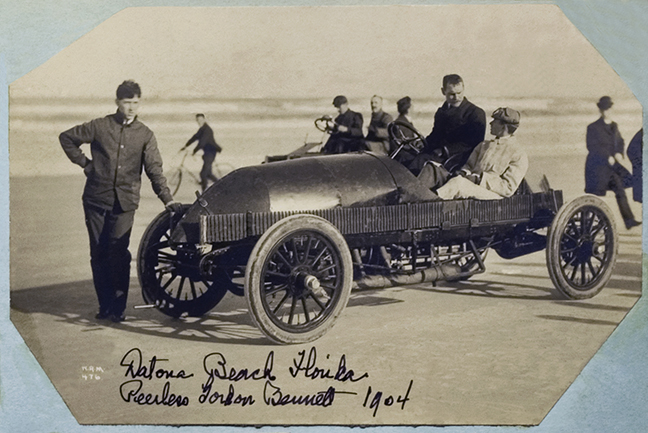
Illgen:Charles Burman is standing at the front of the Peerless driving by Joe Tracy with a different riding mechanician in the seat at the 1904 Ormond Daytona Automobile Races That might be Bill Staring, who I believe accompanied Mooers to Europe for the Gordon Bennett Cup.?
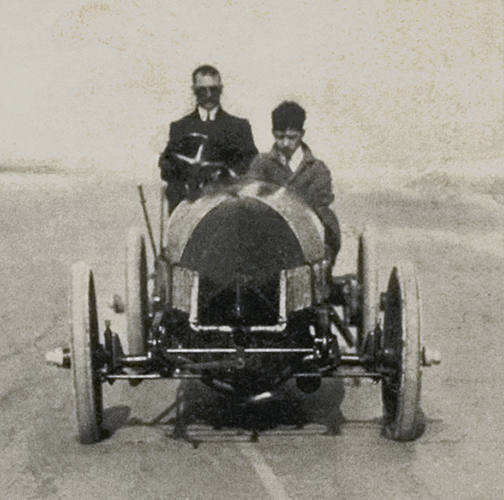
Illgen: Charles Burman can be seen here with Joe Tracy as the riding mechanician at the 1904 Ormond Daytona Automobile Races.
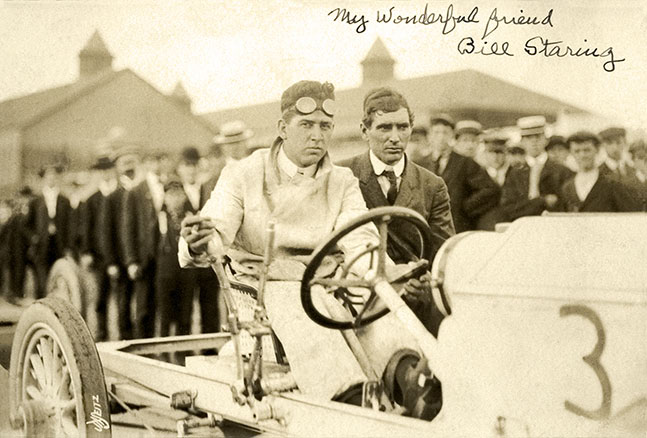
Illgen: Driver Charles Burman can be seen with mechanician Bill Staring in the Peerless that won the 1905 National Championship Race in Cleveland.It is interesting to note that Burman is holding a lit cigar, and that he scowls at the camera, maybe as part of the hard driving and barnstorming Barney Oldfield persona- a look that turned happy and playful for Burman in later photos. Part of the complications of tracking the various "Dragons," is that in the advance promotions and posters for the barnstorming, the cars appeared to be called different names. This, I believe, was "The Blue Streak," named after one of Barneys' earlier two wheel racers.
From Howard Kroplick
August 12, 1905 AAA National Championship, Cleveland Ohio
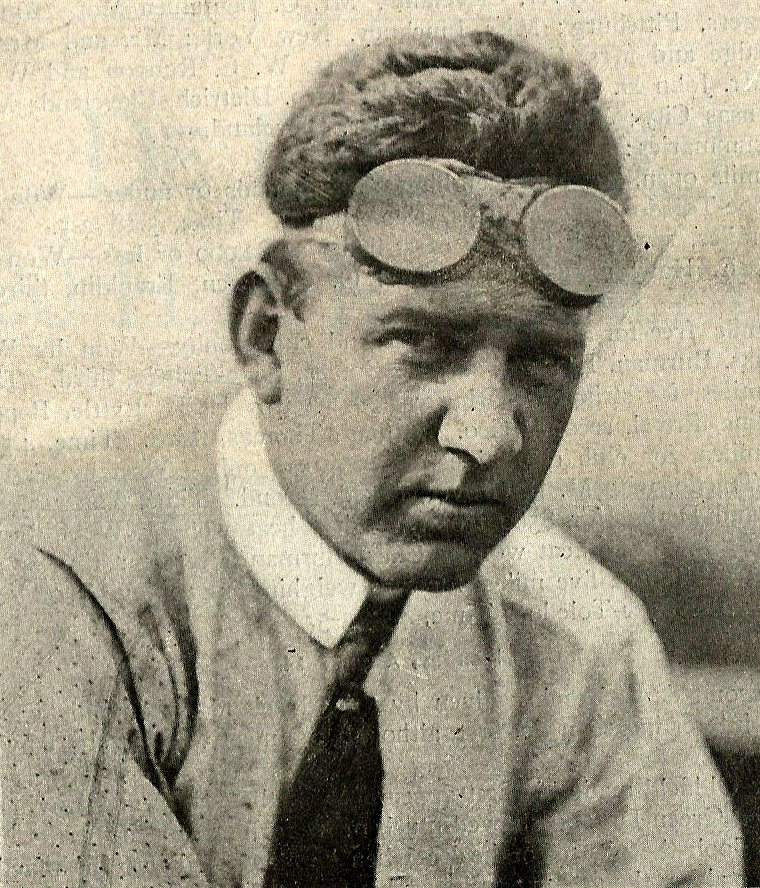
Charles Burman, The New Star in the Racing Firmament

Burman at Full Speed on the Homestretch
Motor Way, August 10, 1905
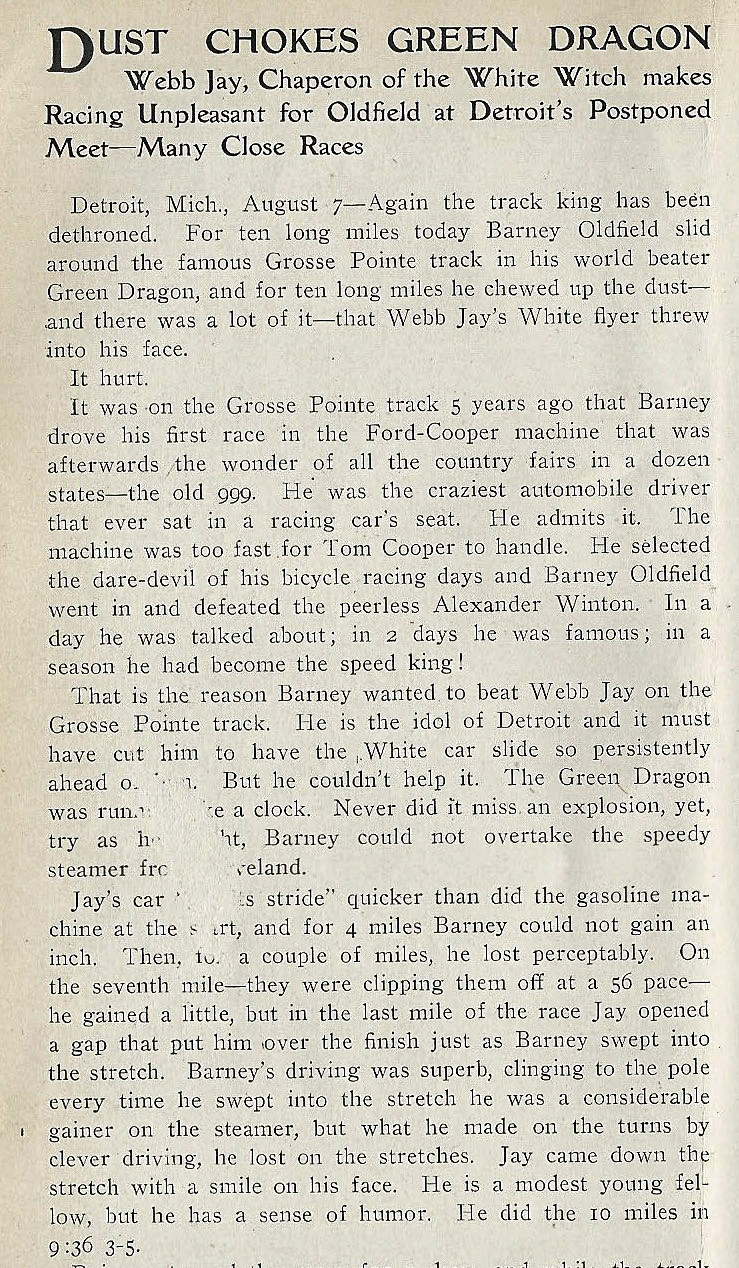
Grosse Point Track Race, Detroit, Michigan, August 8, 1905
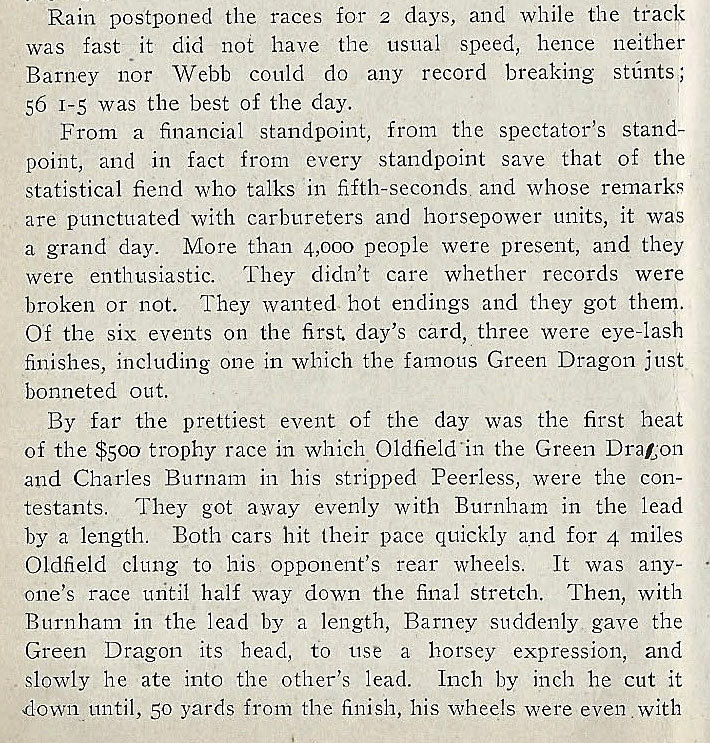
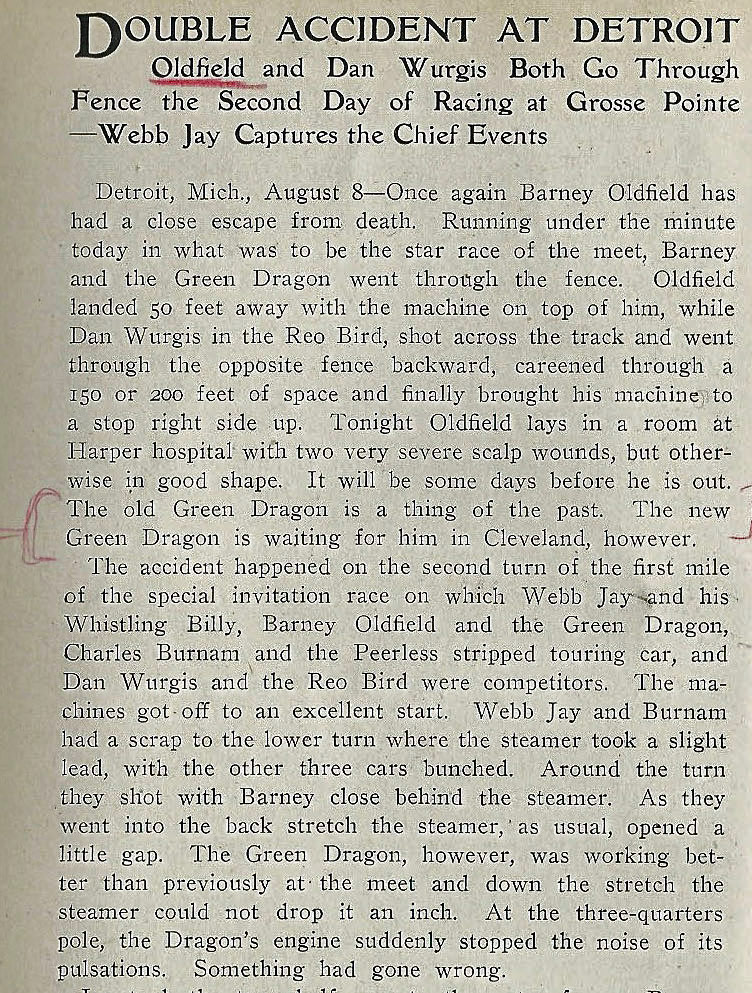
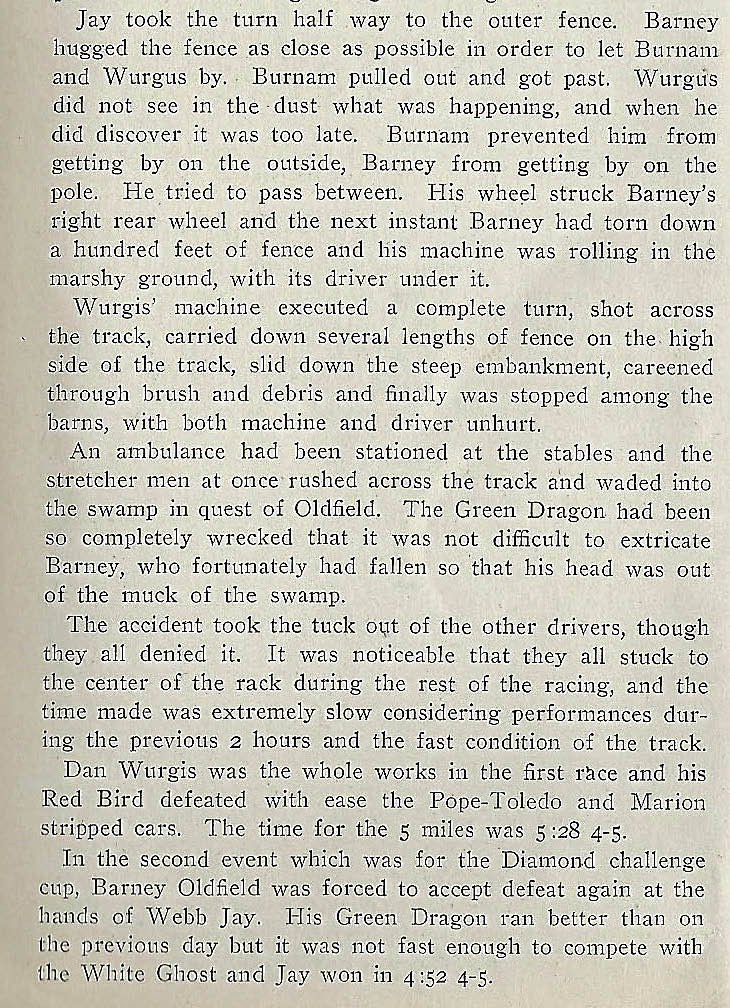
Automobile Topics Illustrated, August 19, 1905
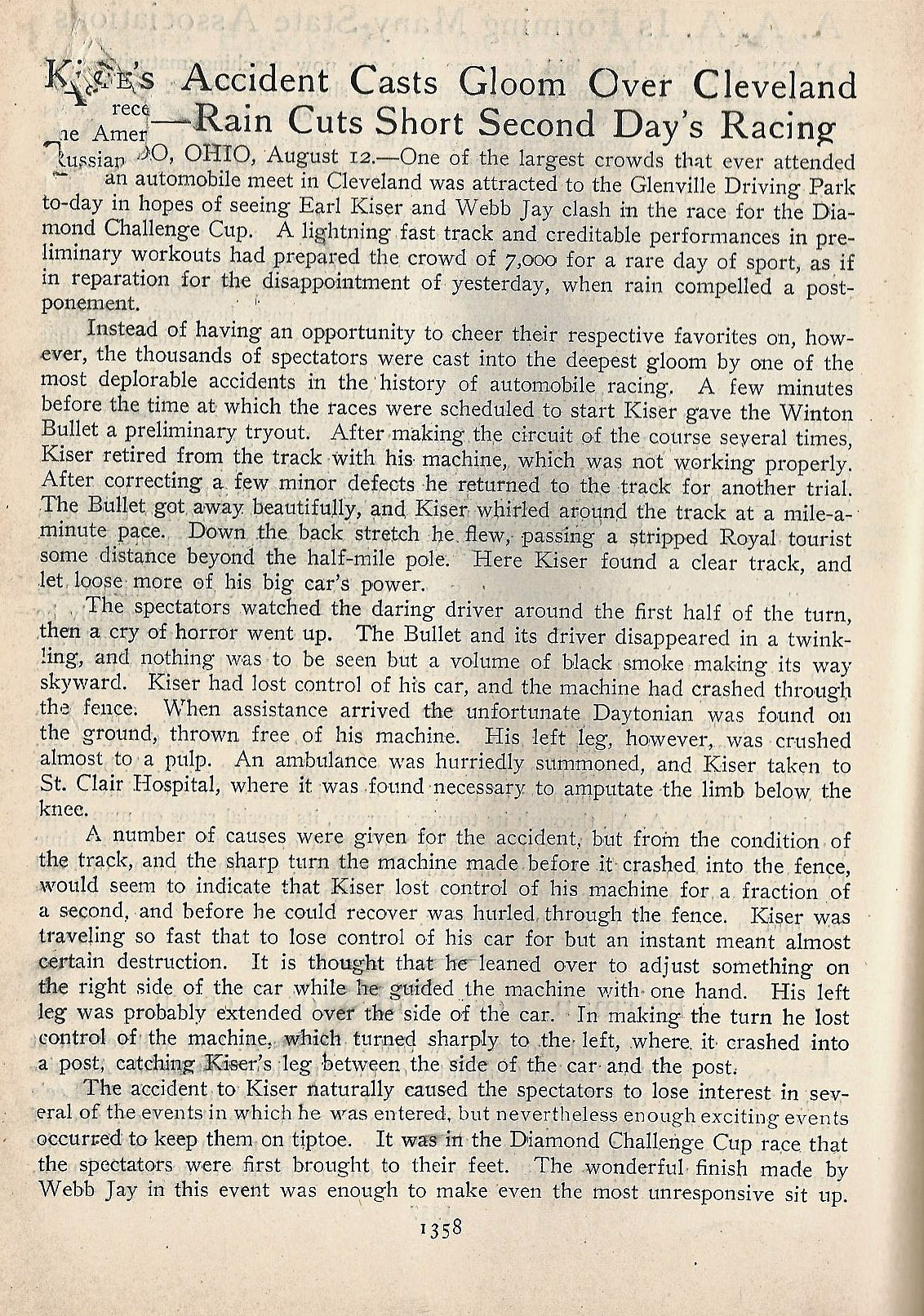
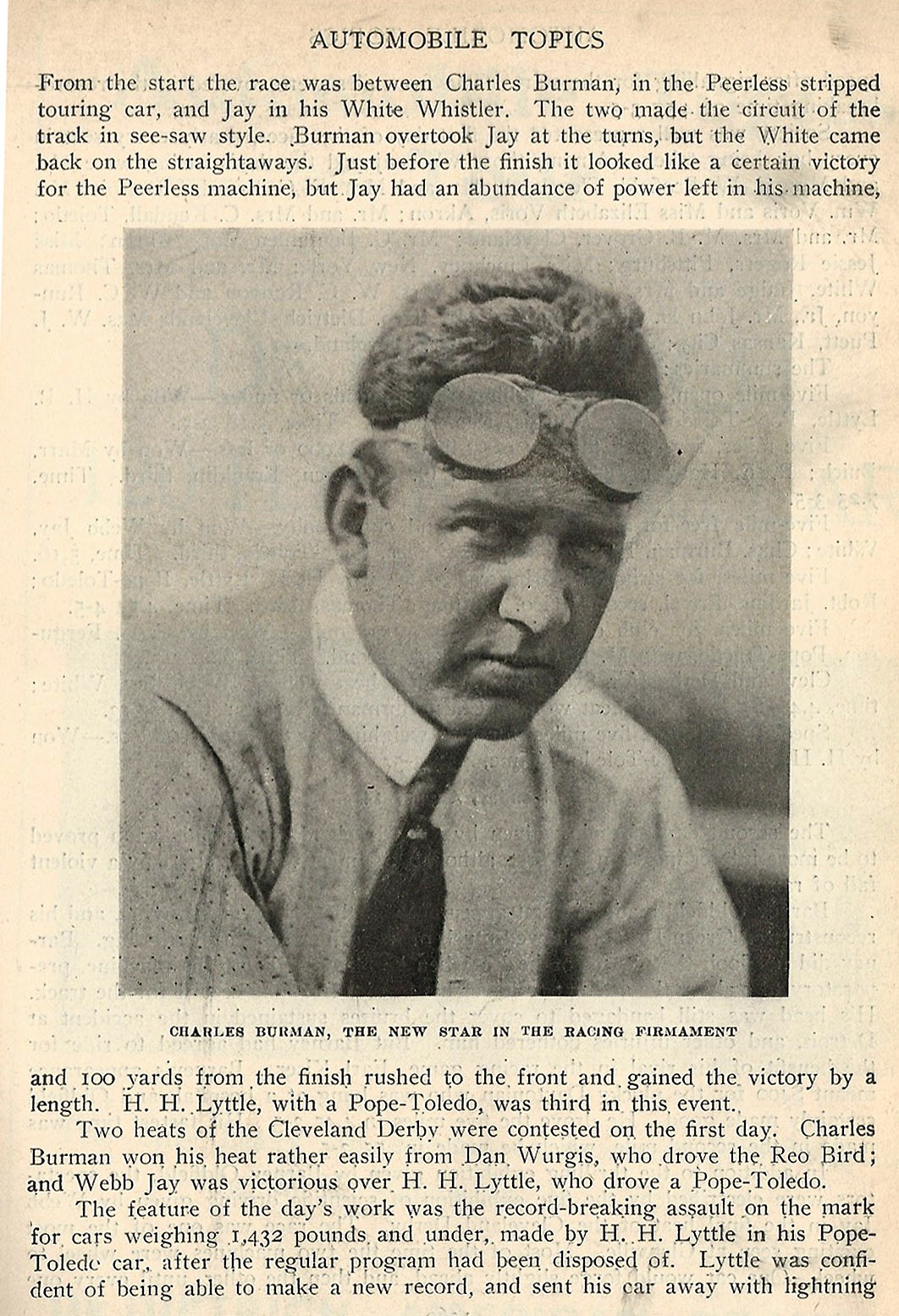
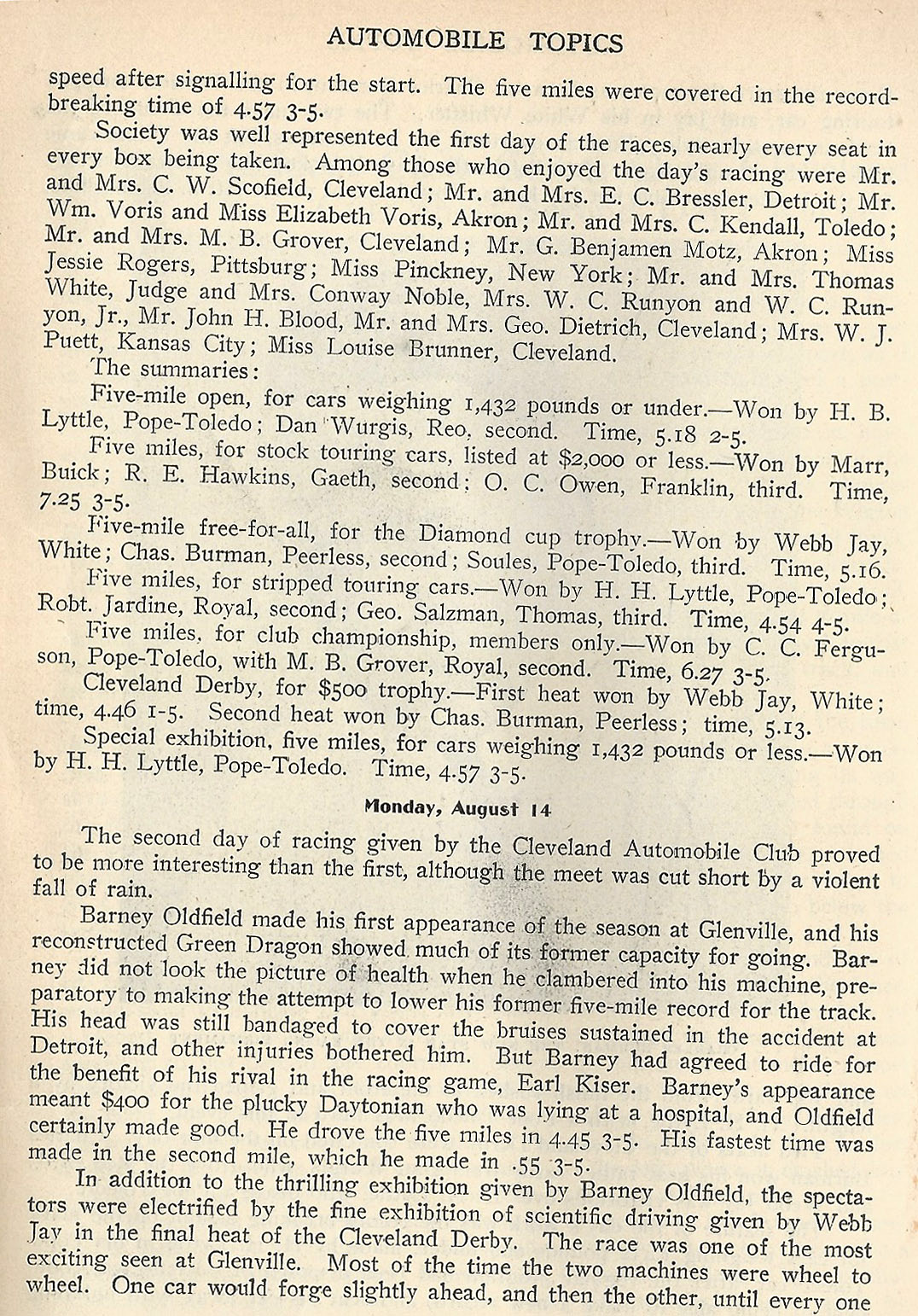
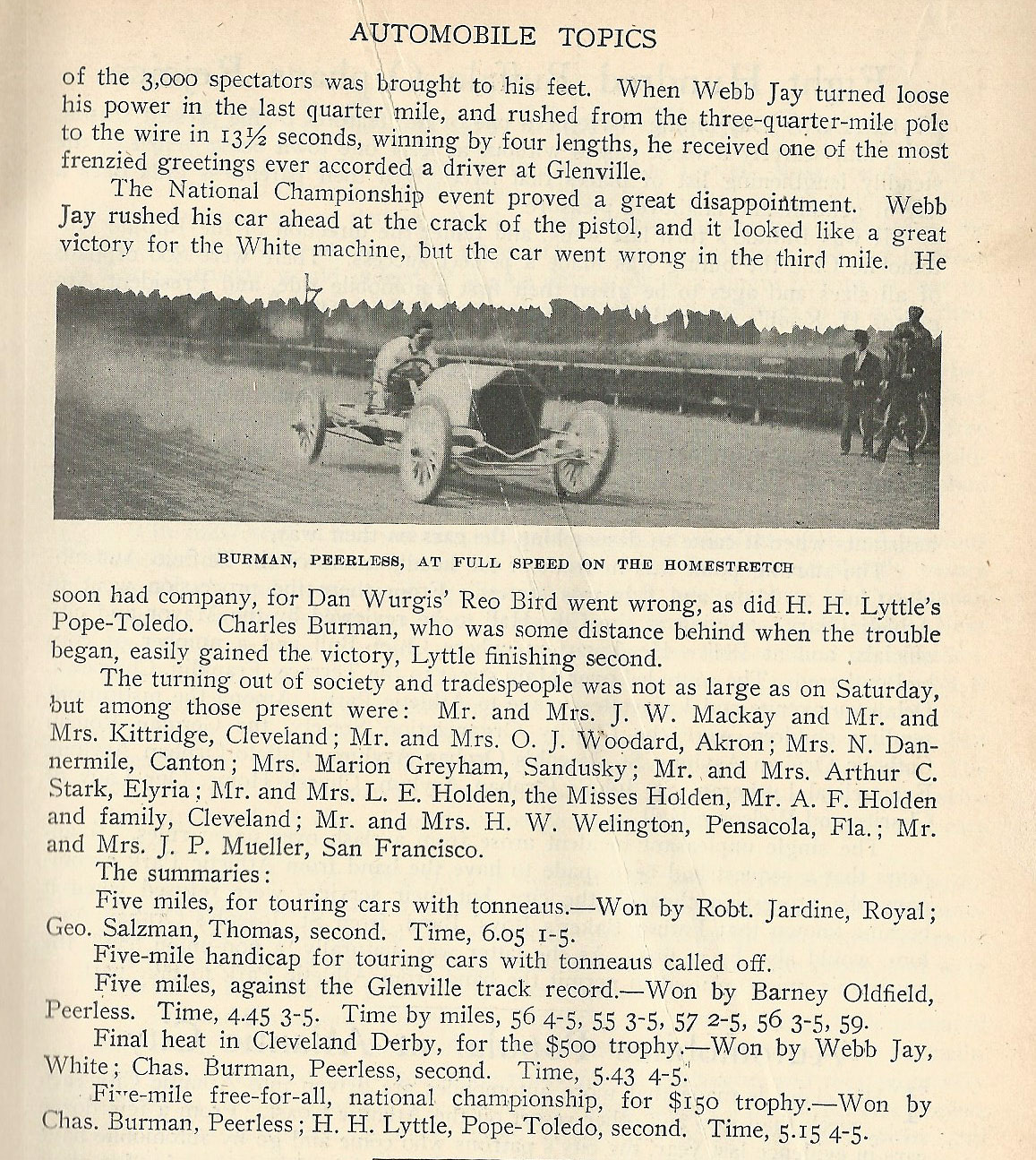
The Automobile, August 17, 1905
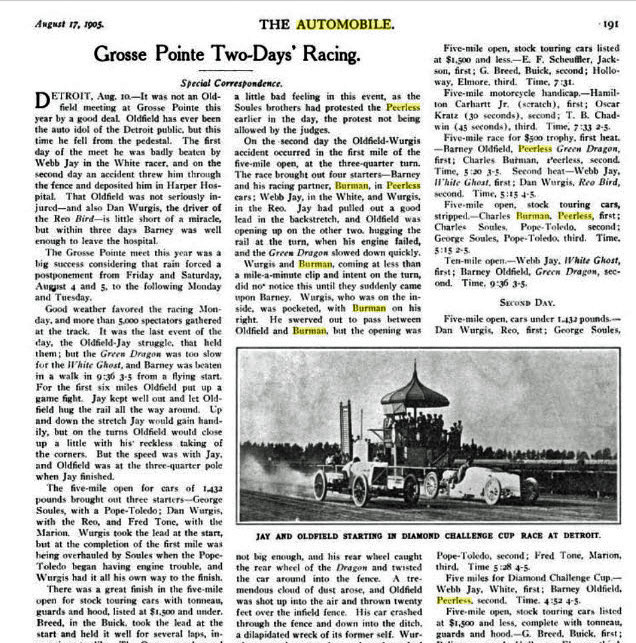
1906 Peerless Sales Brochure from the Cleveland Historical Museum
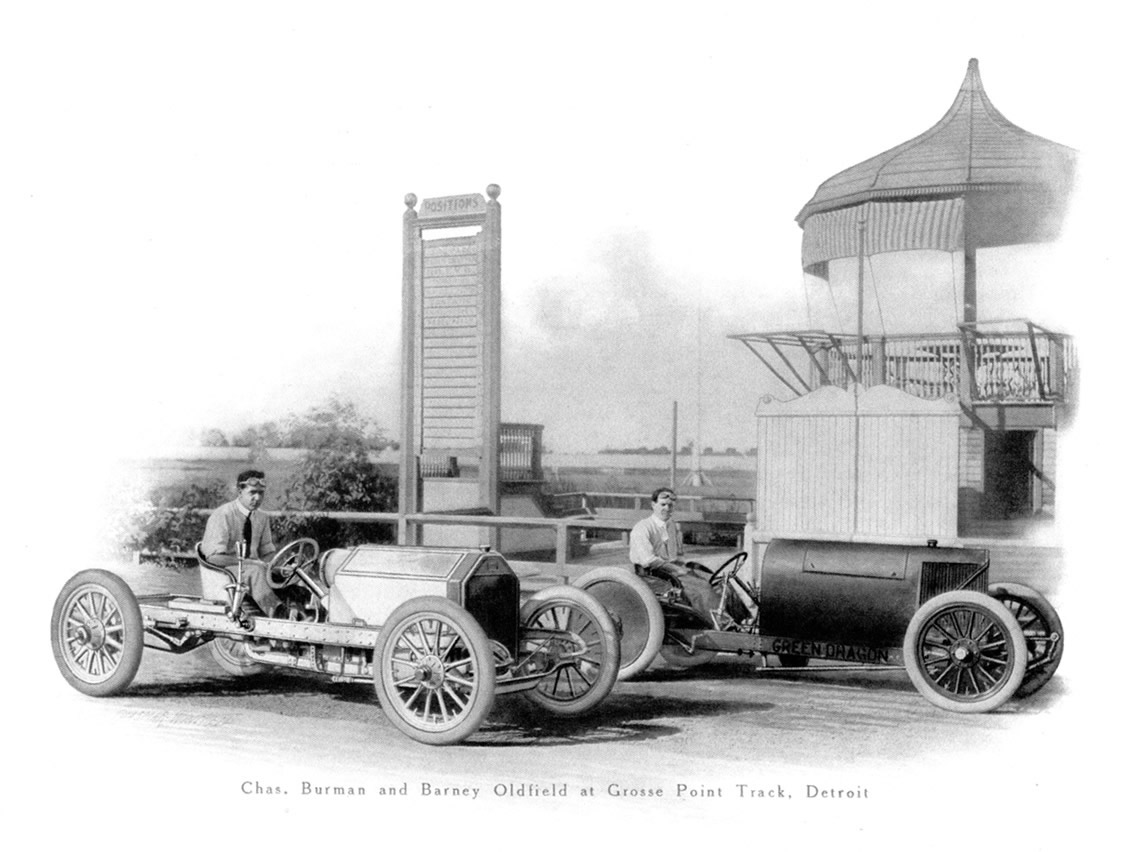
Submitted by Alex Cauthen
1908 Glidden Tour
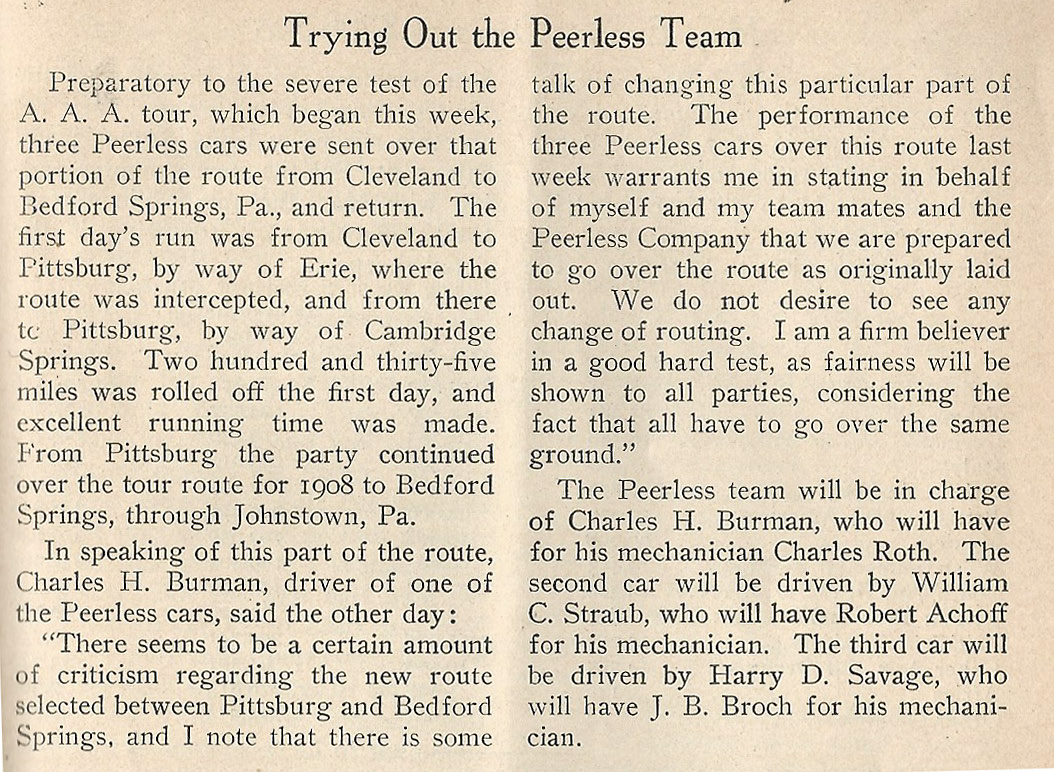
Automobile Topics, July 11,1908
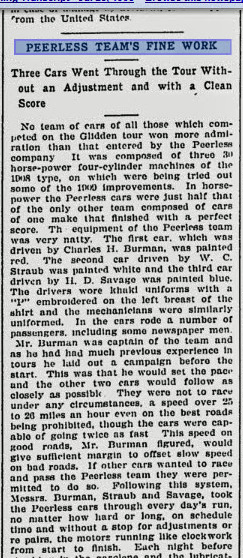
Boston Evening Transcript, July 25, 1908
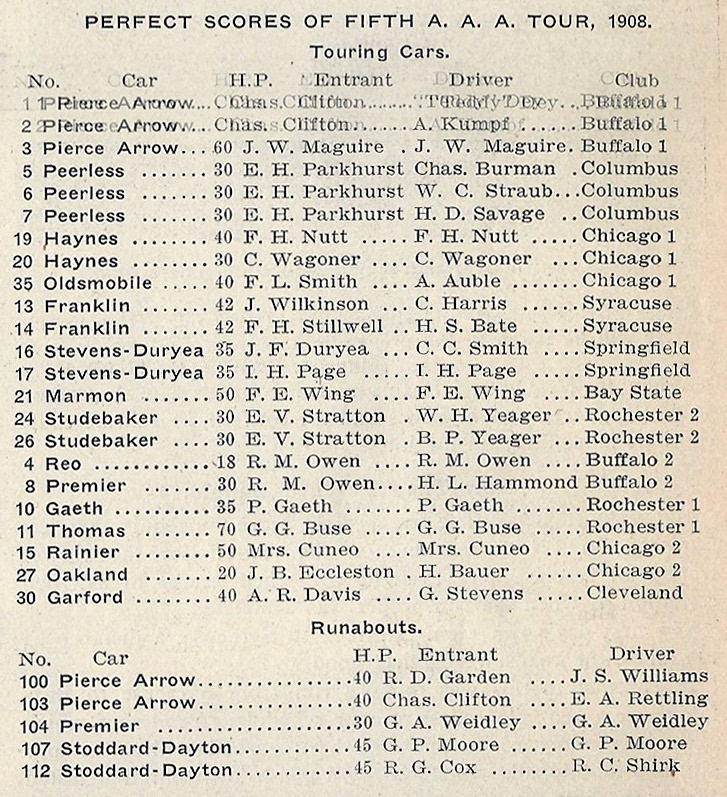
Automobile, July 30, 1908
Charles Burman drove the red #5 Peerless entered by E.H. Parkhurst.
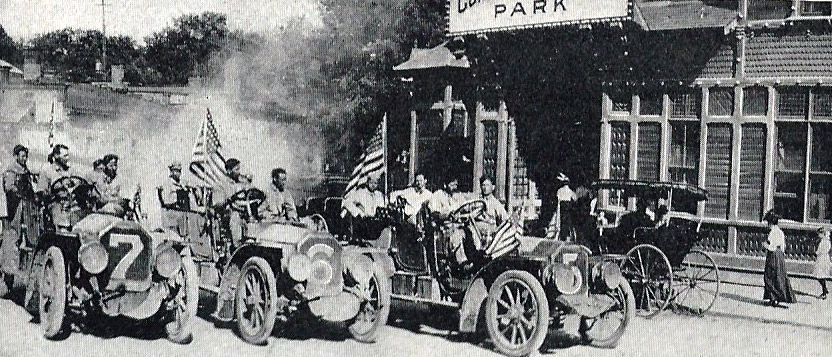
The Peerless Trio Race Team
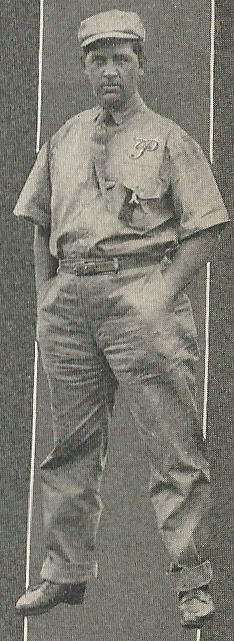
Charles Burman weariing a Peerless shirt
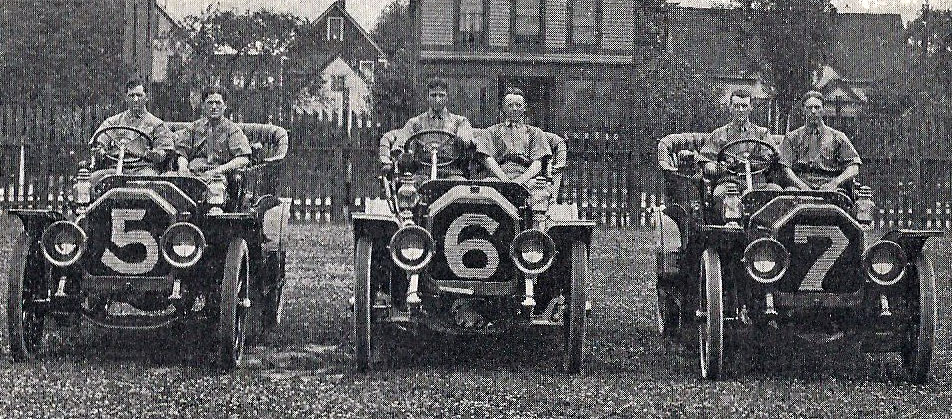
The red, white & blue Peerless team. Charles Burman can be seen on the far left in the red #5.


Comments
Wow, This is the first time I have heard of Charles Burman. I would like to thank Charles M. Illgen and Howard Kroplick for bringing this American Automotive Pioneer to light. Thanks to all for keeping American Automotive History Alive! Barney Oldfield, Master Driver of the World & America’s Legendary Speed King Great Great Nephew
Didn’t remember beans about Charles Burman but racer Bob Burman (23 Apr 1884 Imlay City, Michigan - 08 Apr 1916 ), who you’ve featured, has been well-known to me all my adult life. Burman not being the most common name around, might they have been related? Sam, III
What can I say? The photos are incredible and so is his story.
Rog
I’m writing a book titled “Cleveland, The Original Motor City, 1897-1906” which of course includes much Peerless history, but lacking biographical data on Charles Burman. What can you tell me?
Hello Howard:
Thought that you would be interested in THE ILLGEN CLASSIC…
a four hour race sponsored by the RDC (Racing Drivers Club) and SCCA San Francisco Region in honor of Martin and Margaret Illgen.
Margaret was Charles Burman’s niece.
The automobile defined both Martin and Margaret Illgen’s entire lives, and we can be sure that there was rejoicing in auto racing heaven when they became a couple. They were certainly an effective team and dedicated workers you could count on to “get the job done,” which was one of Martin’s favorite sayings. Theirs was a union of complimentary skills.
From the first light of a race weekend helping Margaret set up registration with his jovial “top of the morning” greeting- accompanied by one of the strongest handshakes you would experience in a lifetime- to the last cleanup details at the end of Sundays’ racing, Martin’s forceful, yet always friendly and positive attitude seemed to dissolve most problems and challenges. He was there to help, sweeping a turn, pushing a car, passing out paper plates, or flipping a burger, it did not matter.
They were both the embodiment of race workers everywhere who show passion, dedication, and the camaraderie that is necessary to organize and conduct a safe race. That exchange of social support went both ways and was never so important as when the racing community rallied to Margaret’s side at the time of Martin’s passing in 1983. The racing clubs provided immense emotional support, giving her strength and meaning to continue on- without her companion. The automotive “family” named the Enduro first in Martin’s honor, then included Margaret, and it is especially fitting that the event is as much about the team work and comradeship as it is about the racing.
Born in Oakland, a major industrial center that celebrated motor racing early, Martin was attracted to the local wooden board tracks that were cheaper to produce than paving a road. There were raceways, dirt tracks, and motorcycle motordromes in the amusement parks of Alameda, Emeryville, and Berkeley. In Elmhurst- a suburb of Oakland before it was incorporated- was a one quarter mile track, with a perfect circle and forty degree banking that would send racers flinging at the spectators lining the upper, outer rim. Later, midget racers were everywhere in the bay area, including inside the Oakland Exposition Building, where your eyes would burn from the smoke and fumes, and Bob Sweikert, 1955 Indy winner would show the way.
Martin’s engineering and technical skills were put to use early, as he made major repairs to the family Cadillac while he was still in high school. The great depression limited his choices, and he worked as a mechanic and tow truck driver for AAA in a shop that one of Margaret’s uncles owned, where she worked as secretary. Love blossomed, and in 1931 a marriage was celebrated and four children followed.
In the late 30’s Martin was working at the motorcycle drome inside the Oakland Oaks ball park and at the Oakland Speedway, maintaining the equipment and driving the “crash truck” that would push the disabled racers aside. The speedway was known as “the fastest dirt track in the nation” where drivers like two time AAA national champion and four time Indianapolis pole starter Rex Mays was unbeatable. Martin- with his huge “popeye” like arms and massive “front feet,” could repair just about any automotive device and used his services throughout the years keeping the “big rigs” running.
Margaret’s family was all things automotive, and had owned a foundry, then a radiator manufacturing business in the “rust belt.” They set up a rental car agency in Victoria B.C. where Margaret was born, and then her uncles- who served as father figures- set up repair shops and automotive dealerships in Oakland and the Bay Area.
In Cleveland, her Uncle Charles Burman- a bicycle racer- worked for Winton Motor Carriage Company in 1900, and moved to Peerless Motor Company a year later. These car builders were the first two American manufacturers to race in Europe in an International competition- The Gordon Bennett Cup. That event in France would become what we now know as Formula One. Europe had a large head start building automobiles and both American companies were soundly beaten. Within two years, the brilliant Peerless designer- Louis P. Mooers- would take the lessons he learned in Europe, build the underslung Peerless “Green Dragons,” and with Barney Oldfield at the wheel and clenching a cigar in his mouth, defeated two time Gordon Bennett winner, Leon Therey, French champion Maurice Bernin, and Italian ace Paul Satori. Oldfield was billed as the “The World’s Premiere Motorist” and Margaret’s uncle was there as his mechanic and racing team mate.
Uncle Charles Burman, as Peerless riding mechanic, raced the sands of Ormond and Daytona Beach at the beginning of 1904 in the reworked Gordon Bennett car. By mid-summer he was driving against Barney’s Green Dragon on a Peerless stripped touring car, setting class and “world” records while barnstorming together in their “mile a minute” racers across the country. In 1905, for the first American National Championship (sponsored by AAA) designer Mooers provided Burma with a purpose built “Peerless Blue Streak.” In the over-slung car, with the engine set low in the frame, Charlie won the Cleveland National race and finished in a four way tie for third place for the year. Barney and the Green Dragon took the first American Championship that today is the The Indycar Series. As track racing became extremely dangerous and drivers were being hurt, a call went out to abolish “the track game.” Peerless dropped from track racing to concentrate on reliability runs as a way of advertising their car’s dependability. Burman stayed on with Peerless and lead three teams to three consecutive year’s perfect Glidden Tour scores and then came to the Bay Area as their west coast representative.
As a conversation piece, Margaret loved to wear her Uncle Charlie’s Champ Car gold medal (from Cleveland) to the races. Working registration, helping out at Race Central, or as head of membership, she was a talker and enjoyed the social aspect of the races. She and Martin would organize the SCCA membership booth at the Import Auto Show, and adjust the family’s Thanksgiving dinner schedule to suit.
In the 1950s, when urban sprawl would claim The Oakland Speedway for a shopping mall, the sports car road races held at places like Golden Gate Park and Pebble Beach, were gaining momentum. Janet Illgen (the oldest daughter) was engaged to Jack Carpenter- an M.G. driving, sports car enthusiast. Jack was working the turns and Martin was immediately on board. In those days, sports car clubs would form a team and “man” a turn, so it was natural that the Illgen family joined up with Jack’s Highland Touring Club. As Buddies, rally co-drivers, and course workers, Jack and “Mart” would come to organize the turn crews, write the first workers manual that unified the flag and emergency signals, set up flagging stations at tracks such as Crow’s Landing, The Port of Stockton, Sears Point and Laguna Seca. They helped pioneer many of the safety features that made the San Francisco SCCA one of the best racing organizations in the world. Between them they would hold the Chief Turn Marshal title for decades. Martin was particularly proud when Stirling Moss- driving his first day of practice at Laguna Seca- pulled to the side of the course at the top of the corkscrew, pointed at “Marty”, motioned him over, and told him he had the best flagging crew in the world! Stirling liked the team’s use of the passing flag.
The Illgens would continue working until their last days as Race Chairman and Membership Chief, giving as only they could, and pulling from the vast reservoir of love and support that is the racing community.
https://www.facebook.com/Racing-Drivers-Club-139573216074670/
*
Alex Cauthen has added an image form a 1906 Peerless sales brochure.